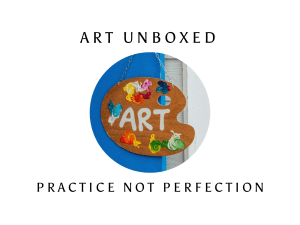Art Unboxed Practice Not Perfection

The painting doesn’t have to be perfect in the beginning of your art journey. At first it won’t be, for me, this was one of the biggest barriers to begin painting. What I didn’t realize is, after one thousand paintings, while it will be much better, and should be, it still won’t be perfect.
What I didn’t realize is, as simple as it may sound, if you paint a crooked line which is supposed to be straight, it can be fixed once you know how. In acrylics and oils, it’s as simple as covering up the wrong parts with another color, and filling in the areas that need fixed. X-rays and scientific analysis reveal that even legendary painters fixed goofs.
In watercolor fixing may mean adding a dark background over a mistake, or turning the mistake into a feature. One of the greatest skills of painting is knowing how to fix mistakes. You will make mistakes, but that’s part of learning.
Whether you call it fixing, repositioning, rethinking, or changing course, it’s an amazing skill. It’s not one that’s learned over night, it takes experience, time, and mistakes. There will be moments where a mistake on a painting is unfixable. Knowing when to start over, and when to keep working on it happen over time.
To learn to paint, you must paint. The same is true of writing, but no one has to see your first paintings. If you’ll comfortable with sharing that’s wonderful, but know that you don’t have too. When you share, smile at the thank yous, smile at the critiques, and learn from both, but don’t hold on to either too tightly.
If the criticism is wrong, in time you’ll know it, but at least consider it. Once you have extracted the value from it, discard the pain, we all make mistakes. Remember, not every Van Gough is a masterpiece, and even Picasso had a trashcan.
Also don’t fall in love with the compliments. If they’re healthy remember them, if they’re too over the top get rid of them too. At time’s success can be more dangerous than failure, even in paint.
Don’t allow fear of failure to keep your brush on the easel. A canvas can be fixed, painted over, or replaced. You need time with a brush in your hand to become the painter you can be.
If you don’t have a lot of time, drawing or watercolor are easily accessible tools, and quickly put up. Even if your goal is to be an acrylic or oil painter, drawing, watercolor, and gouache are great for practicing. It’s not about perfection, it’s about learning, improving, and overcoming the corners we paint ourselves into.



